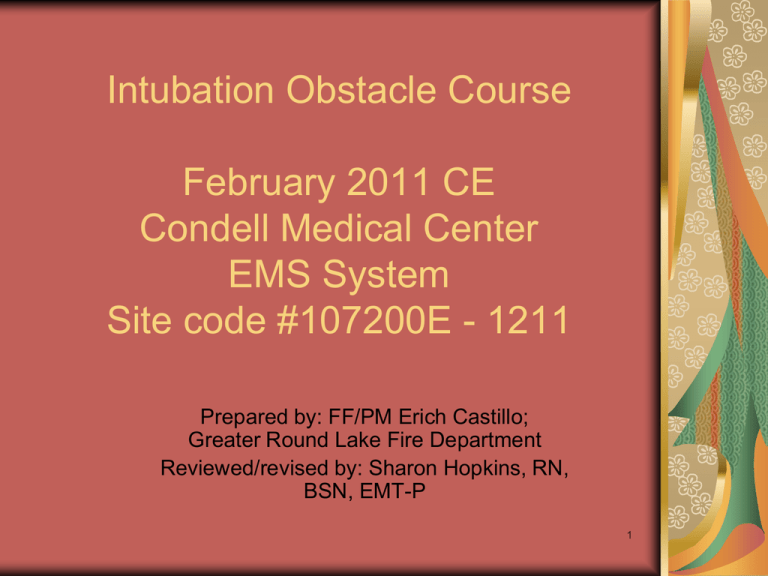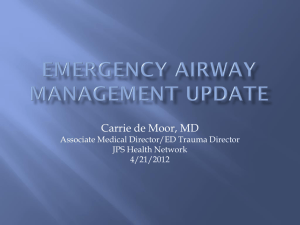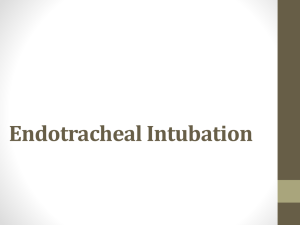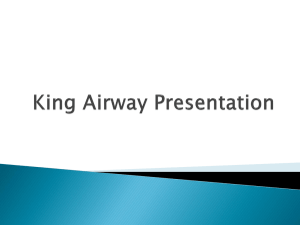Intubation Obstacle Course
advertisement

Intubation Obstacle Course February 2011 CE Condell Medical Center EMS System Site code #107200E - 1211 Prepared by: FF/PM Erich Castillo; Greater Round Lake Fire Department Reviewed/revised by: Sharon Hopkins, RN, BSN, EMT-P 1 Objectives Upon successful completion of this module, the EMS provider will be able to: 1. Describe the airway anatomy in the adult, child and infant populations. 2. Explain the pathophysiology of airway compromise. 3. Review the use of oxygen therapy in cases of airway management in severe situations. 4. Describe the measurement, placement, and assessment of oropharyngeal and nasopharyngeal airways. 5. Explain the value of performing advanced airway procedures. 2 Objectives cont’d 6. List indications, contraindications, and complications of ET intubation. 7. List equipment required for oral intubation. 8. Explain the rationale for having a suction unit immediately available during intubation attempts. 9. State the time limit for suctioning in the adult, child and infant populations. 10. Describe the methods of choosing the appropriate sized endotracheal tube in an adult, child and infant populations. 11. Explain the rationale for using the stylet during intubation. 12. Describe the proper use of a stylet in orotracheal intubation. 3 Objectives cont’d 13. Describe the landmarks used with the Macintosh and Miller blades for oral intubation. 14. Describe the skill of orotracheal intubation in the adult, child and infant populations. 15. Describe the steps in confirming endotracheal tube placement in the adult, child and infant patient. 16. Describe the use of the ETCO2 monitor. 17. Describe the use of capnography to monitor patient condition. 18. State the consequence of and the need to recognize unintentional esophageal intubation. 19. Explain the rationale for securing the endotracheal tube. 4 Objectives cont’d 20. Describe the technique of securing the endotracheal tube in the adult, infant and child populations. 21. Review documentation components of the patient who has been intubated. 22. Demonstrate the skill of measuring and placing the oropharyngeal and nasopharyngeal airways in the adult patient. 23. Demonstrate the skill of orotracheal intubation in the adult patient. 24. Demonstrate confirmation of endotracheal tube placement in the adult patient. 5 Objectives cont’d 25. Demonstrate the skill of securing the endotracheal tube in the adult patient. 26. Demonstrate the skill of intubation on the adult patient with multiple challenges and multiple obstacles confining the patient (inline, face to face, in confined space, digital intubation, with a foreign body). 6 Upper and Lower Airways Upper airway structures Nose Mouth / Pharynx Lower airway structures Alveoli 7 Pediatric Airway Funnel Shaped Peds Airway Adult Airway 8 Airway Compromise Blockage Improper positioning Foreign bodies Improperly placed ETT Swelling Trauma Blunt, crushing injury Burns Improper use of airway adjuncts Disease Asthma Croup Epiglottitis 9 Oxygen Therapy If the patient is in dire need and requires oxygen, the maximum amount is to be delivered Airway compromise Shock Impending arrest Arrest Use best tool for the situation Non-rebreather BVM 10 Future Trend - Oxygen Therapy New research = future practice Hyperventilation pitfalls intrathoracic pressure which CO Compromises systemic blood flow Hypocapnia (low CO2) may worsen global brain ischemia due to excessive cerebral vasoconstriction 100% O2 worsens short-term functional outcome compared to titrated O2 use to SaO2 of 94-96% 11 New SOP’s Coming Watch for revisions in oxygen administration guidelines coming to you in the revised SOP 2011 More to follow! 12 “Securing” the Airway Definition of a secured airway Whatever it takes to have and maintain an open airway Whatever it takes to ventilate the patient Whatever it takes to maintain adequate oxygenation levels New trend: oxyhemoglobin saturation > 94% Includes use of positioning and airway adjunct tools – basic and advanced 13 Open vs Blocked Airway Vocal Larynx cords Tongue Trachea Esophagus Positioning of airway important for keeping airway open 14 Airway Maneuvers Head-tilt / chin lift Maneuver used to open the airway to relieve obstruction by the tongue Reliable, dependable Often under-utilized skill Recommended for all unconscious patients If suspected cervical spine injury, perform modified jaw thrust with in-line stabilization of the cervical spine 15 Airway Adjuncts Mechanical airways Helps lift base of tongue forward, away from posterior oropharynx Does not replace good head positioning Oropharyngeal NOT airways for patients with a gag reflex!!! Nasopharyngeal Tolerated airways by patients with and without gag reflex 16 Oropharyngeal Airway Noninvasive; follows curve of palate Indicated in patients with NO gag reflex Check for presence of blink reflex Facilitates suctioning Can be used as a bite block to protect an endotracheal tube Does NOT protect from aspiration 17 Oropharyngeal Airway 1 Measure 2 Place 3 Assess Check that the tongue was not inadvertently pushed back blocking the airway 18 Nasopharyngeal Airway Uncuffed soft tube; follows curve of nasopharynx to just below base of tongue Indicated for soft tissue upper airway obstruction Tolerated by patients with and without gag reflex Not recommended for facial or head trauma Can cause more trauma during placement 19 Nasopharyngeal Airway 1 Measure 2 Place 3 Assess 20 Nasopharyngeal Airway Inserted bevel side toward the septum LUBRICATE; LUBRICATE; LUBRICATE Right nares Right nares slides in Left nares, starts upside down (bevel to the septum) and rotated into position TIP: pull up on tip of nose to straighten curve that may block ease of insertion Did we say LUBRICATE?! Left nares 21 Advanced Airway Techniques Using an invasive device with additional equipment to secure the airway 22 Indications for Intubation Inadequate oxygenation Inadequate ventilation Need to control and remove pulmonary secretions Need to provide airway protection in an unresponsive patient or a patient with a depressed gag reflex 23 Intubation Contraindications Awake patient Airway can be managed less invasively Severe airway trauma or obstruction that does not permit safe passage of an endotracheal tube Cervical spine injury, in which the need for complete immobilization of the cervical spine makes endotracheal intubation difficult (relative contraindication) 24 Potential Complications During Intubation Inability to view vocal cords Breaking teeth/dislodging bridgework Damage to gums Faulty cuff Unrecognized esophageal intubation Unrecognized right main stem intubation Laryngospasm Failure to complete intubation 25 Equipment Required BVM Laryngoscope with curved and/or straight blade ET tube (size of little finger for peds) Extra ET tube – one size up and one size down Stylet Suction unit Oral airways 10 ml syringe Lubricant Gloves Eye Protection Stethoscope Method to secure ET tube in place 26 Opening the Airway & Creating A Seal Proper positioning of patient essential to place airway in best plane possible Proper seal essential when using the BVM Use “EC” technique 27 BVM Assisted Ventilations Hand-held device to provide positive ventilations to patients Absent respirations Ineffective ventilations Must have proper seal to prevent air leakage Rate sufficient for situation Risk of over inflation of lungs, gastric distention, vomiting To support ventilations in presence of spontaneous heartbeat- once every 5 - 6 seconds in adults; once every 3 - 5 seconds in peds up to 8 years of age To ventilate via ET tube – once every 6 - 8 seconds in all peds and adults Suctioning Removes secretions and oxygen!!! May stimulate gagging and vomiting Most EMS patients not NPO! Limit to 10 seconds for adults Limit to 5 seconds in the pediatric population Watch for hypoxia induced bradycardia Suction on removal of catheter only 29 Typical Sizing ETT Generic guidelines Use length based tape (ie: Broselow ) for pediatric sizing guidelines 30 Stylet Used to give form to the ETT Use is by personal preference NEVER to extend past distal tip of ETT Recess tip of stylet approximately 2cm (3/4″) from distal opening Bend over excess stylet to prevent inadvertent trauma to tracheal wall Place tip in “hockey stick” position Could also reform ETT into a curve 31 Straight Blade Miller Blade lifts epiglottis Vocal cords are exposed Direct visualization allowed 30 second time limit to intubate!!! 32 Curved Blade - Macintosh Blade placed in vallecular space Use left forearm to lift anatomy out of way to view vocal cords Lifting motion moves epiglottis out of the way 30 second time limit to intubate!!! 33 Choosing the Correct Pediatric Blade Size Measure using space from tip of blade to notch Measure from child’s upper incisor to angle of jaw within +/- 1/2″ 34 Difficult Airways – What Are You Going To Do? Positioning Peds Anatomy Swelling Obstructions 35 Do you have adequate padding? Evaluate the patient in the horizontal position Draw an imaginary line from ear to shoulders Patient will then be “in line” Add to or subtract padding when cervical spine can be moved Foreign Body Magill forceps Useful to pull out foreign bodies from the airway Vocal cords Can be used to guide ET tube through vocal cords ET tube cuff Magill forceps If you always anticipate you need them, Not a tool you have time to look for – when you need them, you need them NOW What else is out there? What does the literature say? 38 Mallampati Score Tool to evaluate and gain estimate of difficulty of intubation Evaluation obtained while visualizing the anatomy Fewer structures visible=greater difficulty in completing the intubation Used in hospitals and some EMS areas 39 Cricoid Pressure/ Sellick Maneuver Helpful to stabilize anatomical structures Helpful to reduce regurgitation Hazardous if too much force applied and airway is actually compromised during ventilations Palpate cricoid cartilage and press directly backwards 40 “BURP” – Visualizes Cords Backward, upward, right pressure Placed on thyroid cartilage (not cricoid cartilage) Improves visualization of vocal cords during intubation attempt Larynx moved to the right as the tongue is swept to the left with the laryngoscope blade NOT same maneuver as cricoid pressure; used for different results Blind Insertion Airway Devices #1 1. Combitube 2. King LT-D airway 3. LMA #2 Not as effective as ETT in preventing aspiration Useful in unsuccessful traditional #3 ETT placement More information coming related to this equipment with 2011 SOP updates 42 Medication Assisted Intubation Region X is reviewing the use of medications used to assist in intubation in the non-arrested patient Which drugs are most effective? Which have the least amount of side effects? Which drugs help to get the job done and improve patient outcome? More to come with 2011 SOP updates 43 Standard Oral Intubation Use the curved or straight blade in left hand Use right hand to place ET tube DO NOT slide ET thru blade but along side blade – you still need to visualize your landmarks! 44 View with a blade and good light. Vocal cords and surrounding structures 45 Insertion Techniques for ETT Your positioning may be critical for successful insertion Put the anatomy “in line” to improve visualization Bring your body down to the airway level 46 Confirming ET Tube Placement Direct visualization of vocal cords 5 point auscultation Listen over epigastric area first Then listen upper lobes and midaxillary regions (farthest laterally in peds) Watch for chest rise and fall ETCO2 changing to & maintaining yellow coloring 47 ETCO2 Measures the amount of CO2 exhaled at the end of each breath Perfusion needs to be sufficient to circulate waste products (CO2) back to the lungs to be exhaled Ventilation needs to be adequate to wash the CO2 out of the lungs to be measured Yellow coloring indicates adequate CO2 levels Indicator changes back and forth with the situation 48 Capnography Measurement of exhaled CO2 levels Device displays a tracing and level of readings – similar to an EKG Normal reading is 35 – 45 mmHg Watching wave shape can indicate hypoventilation, hyperventilation, return of spontaneous circulation during CPR Improper ET Tube Placement Huge risk not to identify this complication and immediately take the appropriate intervention Right main stem bronchus Breath sounds absent on left; more chest rise and fall on right While listening over left chest, reposition ET tube until breath sounds are heard Esophageal intubation Epigastric sounds, no breath sounds, no rise and fall of chest Immediately remove ET tube, ventilate/oxygenate patient, reattempt intubation Securing ET Tube NEVER let go of the tube until secured Tape Commercial tube holder ETT easily displaced so requires ongoing assessment 51 Documentation ET Tube Placement On patient care report: ET (size)___depth___cm Post ET lung sounds ET Attempt (x___) Capnography Checked Suction Boxes used to indicate crew member activity 52 Documentation ETT Placement Do your times indicate the patient received ventilations via BVM prior to intubation? Did you document assessment used to confirm tube placement? Do you indicate a ventilation rate of once every 6-8 seconds (8-10 breaths per minute) post intubation? 53 Alternate Techniques for ETT Placement 54 In-line Intubation Used in patients with suspected cervical spine injuries Head and neck maintained in-line without manipulation Best accomplished with 2 persons 1 person at head of patient intubating If sitting, may have to use legs to hold head 1 person to the side holding head and neck Face to Face Helpful for seated patient Use the curved blade in RIGHT hand Use LEFT hand to place ET tube Note: Not hard to do, just needs practice! 56 Digital Intubation Useful if positioning is difficult Rescuer does not have full view of airway Patient may have spinal cord injury Facial injuries distort anatomy Hazardous to rescuer if patient clamps down on fingers Always have sturdy material between teeth 57 Digital Intubation Procedure Place mouth prod to protect fingers from being bitten Stand to patient’s left side Insert left index and middle fingers into patient’s mouth Elevate epiglottis with left middle finger Feels like tragus of ear (area next to canal opening & next to cheek) Insert tube with right hand and guide tube forward into glottic opening with left index and middle fingers 58 Becoming an Expert Intubator Like any psychomotor skill, it takes instruction and practice to perfect ETI. There are five phases in the process of mastering a psychomotor skill Imitation: The student repeats what is done by the instructor. In medicine, this is often referred to as, "See one, do one." 59 Becoming an Expert Intubator Manipulation: The student will use guidelines for skill development, and rely less on the instructor. The student may make mistakes, but correcting mistakes promotes learning. This also allows the student to develop their own style. Precision: The student has practiced to the point where they don't make mistakes. However, they often can't perform the skill as well in a different setting. 60 Becoming an Expert Intubator Articulation: The student is able to integrate both cognition and affect into skill performance. They understand why the skill is necessary and when it's indicated. They perform it proficiently and with style. They can perform the skill in multiple settings. This is the phase that students should reach before graduating an initial educational program. 61 Becoming an Expert Intubator Naturalization: Eventually, the skill is performed without thought. The process has been ingrained into the operator's mind. For example, prior to mastering ETI, a student will reflexively pick up a laryngoscope in their dominant hand (usually right). After mastery, they reflexively pick it up with their left hand regardless of hand dominance. 62 Case Studies Read the accompanying scenarios. What do you think? How would you approach the situation? Is there anything you would do different? Remember to check the notes section for details on the scenarios 63 Case Scenario #1 You are preparing to intubate your patient. If you are using the Miller (straight) blade, where does the tip go? Under the epiglottis to lift it If you are using the Macintosh (curved) blade, where does the tip go? Into the valecullar space 64 Case Scenario #2 How do you secure this airway? 65 Case Scenario #2 You have arrived on the scene of a MVC (auto versus tree) Patient is pinned in the car Respirations are labored How are you going to secure the airway? Need C-spine manual immobilization Intubation possibly face to face May have to lay across hood of car reaching over steering wheel May need to do digital intubation 66 Case Scenario #3 - Documentation Call for low blood sugar - what do you think? Comments: Found 37 y/o female unconscious, lying on floor. Pt’s husband states this happens frequently and she must not have eaten after taking her insulin. Glucose level 30. IV started and Dextrose given. Pt became A&O x3 with blood sugar of 57. Refused further treatment and transport. Release signed. Only information documented under drugs: 0505 – 50% Dextrose - 50ml - IV 67 Case Scenario #4 - Documentation Call for lift assist – what do you think? Comments: responded to residence for male subject who needed assistance to stand. AOx3 sitting on floor. Stated low back pain. Denied LOC, head or neck trauma. Assisted to standing position. Risks and benefits explained. Wife signed refusal. 68 Case Scenario #5 - Documentation Call for unresponsive person – what do you think? Upon arrival found 87 y/o male lying on couch unresponsive. GCS 3. Respirations 6/minute. Log rolled to backboard. Pt cyanotic. Airway opened. Pt moved to ambulance. Put on monitor. NRB mask applied. Medication given for sinus brady. Report to medical control and further orders obtained. Pt transported. Case Scenario #6 - Documentation Call for MVC – what do you think? Dispatched to MVC. UA found 17 y/o pt ambulatory A&Ox3. 4 cars involved. Denies head, neck, back pain but complains of headache. Denied LOC. Refuses transport. Mother contacted and advised to have patient sign the release. Area under “vital signs” marked as DNA 70 Case Scenario #7 - Documentation Called to the scene for a seizure – what do you think? Upon arrival found pt on the floor in an active seizure. Bystanders assisted patient to ground when seizure started. NRB mask applied at 15 L/min. IV established after 2 attempts. Valium administered and seizure activity stopped. Patient remains post ictal. Transported laying on left side. 71 Case Scenario #8 - Documentation Call for low blood sugar – what do you think? Upon arrival found 58 y/o female conscious, alert sitting in bed. Slow to respond. Glucose 27. Husband trying to give glucagon but forgot to reconstitute. Husband also gave oral glucose prior to our arrival. Pt A&Ox3 after dextrose. Pt voiced no complaints. Did not want transport. IV D/C’d. Catheter intact. No infiltration at site. Advised to follow-up with MD, informed of risks and benefits. Pt signed refusal. Check boxes: Alert, cooperative, GCS 4/4/6; 4/5/6; blood glucose levels 27/57/251 72 Case Scenario #9 - Documentation Call for possible overdose – what do you think? UOA found 18 y/o pt with shallow respirations at 4/minute. Bystanders state took unknown drugs about 3 hours ago and has been drinking heavily. Immediately began bagging patient once every 6 seconds. Adequate chest rise and fall. SaO2 increased to 99%.Color improved. No response to Narcan x2. After above meds administered, patient intubated with #8 ET tube. Placement confirmed with bilateral breath sounds, no epigastric sounds, chest rise and fall. ETCO2 yellow. Practical Skills EMT-Basic Measure and place oro and nasopharyngeal airways Practice effective bagging Once every 5-6 seconds with BVM Once every 6-8 seconds via ETT EMT-Paramedic Measure and place oro and nasopharyngeal airways Intubate a manikin Work with manikin in a variety of positions Try regular, in-line, face-to-face, and digital 74 Questions? 75 Bibliography American Heart Association. 2010 Guidelines for Cardiopulmonary Resuscitation. Bledsoe, B., Porter, R., Cherry, R.. Essentials of Paramedic Care 2nd Edition. Brady. 2011. Campbell, J.E., International Trauma Life Support 6th Edition. Brady. 2008 Journal of Emergency Primary Health Care. Article #990101. Vol 3 Issue 1-2. 2005 Suprun, S. C. New Airway Models in the Fast Lane. Fire Engineering. May 1, 2005. www.cic.ahajournals.org/cgi/content/full/122/18_su ppl_3/S640 www.Fireengineering.com www.4um.com/tutorial/icm/intubate.htm http://images.pennet.com/articles/ems/thm/th_132 76 305.jpg






